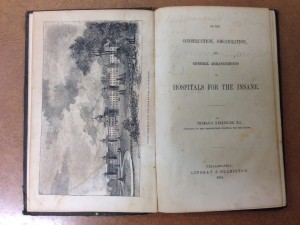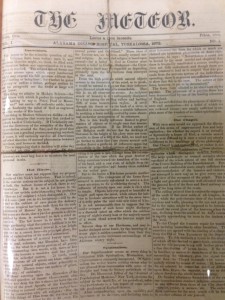By: Ellie Campbell, JD and University of Alabama MLIS graduate student
In 1861, Bryce Hospital opened in Tuscaloosa, Alabama. The hospital provided for the care of the mentally ill in Alabama, and was inspired by the ideas and activism of Dorothea Dix, a reformer who studied their care in Great Britain and across the U.S. Dix believed that government should play a direct role in social welfare, and she lobbied many state governments and the U.S. federal government to create asylums to care for the mentally ill. Prior to her efforts, treatment for the indigent and mentally ill across the U.S. was virtually unknown, with those who lacked resources or family to care for them confined to local prisons or almshouses. Support for a state hospital in Alabama began in the 1840s, and plans for Bryce were confirmed by the state legislature in 1852. Dix recommended Dr. Peter Bryce, a psychiatric pioneer from South Carolina, as the head of the new facility. Originally named the Alabama Insane Hospital, it was later renamed for Dr. Bryce.
Bryce Hospital’s founding and early years, governed by the leadership of Dr. Bryce, were marked by a progressive approach to the treatment of the mentally ill. Bryce Hospital’s architecture utilizes the Kirkbride Plan, a building design created by Philadelphia psychiatrist Thomas Kirkbride, another mid-nineteenth century mental illness reformer. Like Dix, he advocated for the humane treatment of the mentally ill, and designed plans for asylums and hospitals to provide for their comfort and privacy. These institutions, including Bryce Hospital, often featured extensive grounds and farmland to be worked by patients for physical exercise and therapy. The hospital also emphasized occupational therapy and humane, respectful treatment of patients. Bryce Hospital was the first in the U.S. to unshackle patients and discourage the use of straitjackets. It also promoted work programs, and patients even published their own newspaper, The Meteor, from 1872-1881.
Unfortunately, Bryce Hospital’s progressive approach and scant funding from the legislature could not cope with the sheer number of people who needed treatment. By 1875, Dr. Bryce noted that the hospital had become more of a warehouse for the mentally ill and less of a rehabilitative center. The late nineteenth century also brought the rise of the new “science” of eugenics, a body of thought that supports improving the human race through encouraging the reproduction of people with desirable traits and discouraging the reproduction of people with undesirable traits. In practice, these beliefs resulted in forced sterilizations, support for racial segregation and the segregation of the mentally ill, forced abortions or forced pregnancies, forced euthanasia, and genocide.
To reduce mental illness, eugenicists in Alabama advocated restrictive marriage laws, sexual isolation, forced sterilization, and restricted immigration for the mentally ill. In the early twentieth century, James Searcy, the superintendent of Bryce, and his chief assistant William Partlow, were regional leaders in the eugenicist movement. Partlow sterilized all patients released from the hospital for fifteen years, and lobbied the legislature to pass a compulsory sterilization law.
During the 1930s, the Alabama legislature did pass a law giving superintendents of state mental institutions discretion to sterilize a wide range of patients, including those “habitually and constantly dependent upon public relief or support of charity.” The law did require some evidence of degeneracy, but it did not provide for judicial review. The measure was supported by several major Alabama newspapers and the mental health community, including scientists at the University of Alabama. It was opposed by a group of strange bedfellows, including organized labor, Catholics, leaders in the Baptist community, and the Alabama Supreme Court, which issued an advisory opinion that the law violated the due process of the U.S. Constitution. Fortunately for the state, Gov. Bibb Graves vetoed the law, mostly due to pressure from religious groups.
Meanwhile, conditions at Bryce and other mental hospitals in Alabama continued to decline over the course of the twentieth century. By the 1960s, patients received virtually no treatment in facilities that were overcrowded, filthy, understaffed, and underfunded. Daily food allowances came to less than fifty cents per person.
A class action lawsuit, Wyatt v. Stickney, was filed in 1970; circumstances were so bad that even mental health professionals who were being sued testified on behalf of the plaintiffs. The U.S. Attorney for the case, Ira DeMent, toured Bryce and found that beds lacked sheets, patients slept on floors, shower stalls did not work, human feces were caked on toilets and walls, and one small shower stall served 131 men and another 75 women. At the time, state appropriations for the mentally ill averaged less than seven dollars a day, half the rate of adjacent states. The legislature attempted to pass reform but could not.
After their failure, Judge Frank M. Johnson, Jr., issued his landmark opinion in Wyatt v. Stickney in 1971, ruling for the first time in American legal history that mentally ill and handicapped patients have a constitutional right to minimum standards of care. The case was upheld by the U.S. Supreme Court, but the legislature still dragged its feet in implementing the new care standards, complaining of federal judicial activism.
Federal health officials did not begin monitoring Bryce and other hospitals for compliance until 1977, when forced field labor, which has since been billed as a type of work therapy, ceased. The state did not sign a consent decree to provide adequate care until 1986. The state was finally declared in compliance with the new standards in 2003.
The University of Alabama acquired Bryce Hospital in 2009, and patients were moved to a new facility elsewhere in Tuscaloosa. Now, Bryce Hospital is the focus of a historic preservation project and the Alabama Department of Mental Health released a fact sheet summarizing the hospital’s history.
For further reading, see:
Flynt, Wayne. Alabama in the Twentieth Century. Tuscaloosa: University of Alabama Press, 2004. Especially p. 212-218.
Larson, Edward J. Sex, Race, and Science: Eugenics in the Deep South. Baltimore: Johns Hopkins University Press, 1995.




2 Responses to Bryce Hospital: An Introduction